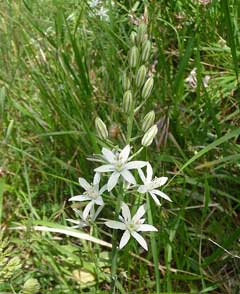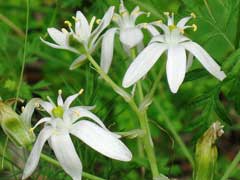 |
|
http://commons.wikimedia.org/wiki/User:Lucarelli |
 |
| commons.wikimedia.org/wiki/File:Ornithogalum_narbonense_from_Kedumim.JPG |
Translate this page:
Summary
Physical Characteristics

 Ornithogalum narbonense is a BULB growing to 0.4 m (1ft 4in) by 0.2 m (0ft 8in).
Ornithogalum narbonense is a BULB growing to 0.4 m (1ft 4in) by 0.2 m (0ft 8in).
See above for USDA hardiness. It is hardy to UK zone 7. It is in flower from April to June, and the seeds ripen from June to August. The species is hermaphrodite (has both male and female organs) and is pollinated by Insects.
Suitable for: light (sandy), medium (loamy) and heavy (clay) soils. Suitable pH: mildly acid, neutral and basic (mildly alkaline) soils. It can grow in semi-shade (light woodland) or no shade. It prefers moist soil.
UK Hardiness Map
US Hardiness Map
Synonyms
O. arcuatum. O. pyramidale narbonense.
Plant Habitats
Meadow; Cultivated Beds;
Edible Uses
Edible Parts: Root
Edible Uses:
Bulb[46, 61, 177]. No further details are given, though it is probably cooked before being eaten. Some caution is advised, see the notes above on toxicity.
References More on Edible Uses
Medicinal Uses
Plants For A Future can not take any responsibility for any adverse effects from the use of plants. Always seek advice from a professional before using a plant medicinally.
None known
References More on Medicinal Uses
The Bookshop: Edible Plant Books
Our Latest books on Perennial Plants For Food Forests and Permaculture Gardens in paperback or digital formats.

Edible Tropical Plants
Food Forest Plants for Hotter Conditions: 250+ Plants For Tropical Food Forests & Permaculture Gardens.
More

Edible Temperate Plants
Plants for Your Food Forest: 500 Plants for Temperate Food Forests & Permaculture Gardens.
More

More Books
PFAF have eight books available in paperback and digital formats. Browse the shop for more information.
Shop Now
Other Uses
References More on Other Uses
Cultivation details
An easily grown plant[90], it succeeds in any position[42] in ordinary garden soil[1]. Prefers a sunny position[200]. Succeeds in short grass[90], though this should not be mown from the time the bulbs start to grow until they have set seed and the leaves are dying down. Plants are hardy to about -10°c[200].
References Carbon Farming Information and Carbon Sequestration Information
Temperature Converter
Type a value in the Celsius field to convert the value to Fahrenheit:
Fahrenheit:
The PFAF Bookshop
Plants For A Future have a number of books available in paperback and digital form. Book titles include Edible Plants, Edible Perennials, Edible Trees,Edible Shrubs, Woodland Gardening, and Temperate Food Forest Plants. Our new book is Food Forest Plants For Hotter Conditions (Tropical and Sub-Tropical).
Shop Now
Plant Propagation
Seed - best sown as soon as it is ripe in a cold frame[200]. Sow the seed thinly and leave the seedlings undisturbed in the pots for their first dormancy, but apply liquid feed at intervals, especially in their second year of growth. Divide the bulbs at the end of their second year of growth, putting 2 - 3 bulbs in each pot. Grow them on for one more year and them plant them out into their permanent positions whilst they are dormant. The seed can also be sown in a cold frame in early spring. Division of offsets in September/October[200]. The larger bulbs can be replanted immediately into their permanent positions. It is best to pot up the smaller bulbs and grow them on for a year before planting them out when dormant in late summer.
Other Names
If available other names are mentioned here
Native Range
TEMPERATE ASIA: Cyprus, Iran, Israel, Jordan
EUROPE: Albania, Bulgaria, Greece, Italy (incl. Sardinia, Sicily), Spain, France (incl. Corsica) AFRICA: Spain (Canarias), Algeria, Libya, Morocco, Tunisia
Weed Potential
Right plant wrong place. We are currently updating this section.
Please note that a plant may be invasive in one area but may not in your area so it's worth checking.
Conservation Status
IUCN Red List of Threatened Plants Status :

Growth: S = slow M = medium F = fast. Soil: L = light (sandy) M = medium H = heavy (clay). pH: A = acid N = neutral B = basic (alkaline). Shade: F = full shade S = semi-shade N = no shade. Moisture: D = dry M = Moist We = wet Wa = water.
Now available:
Food Forest Plants for Mediterranean Conditions
350+ Perennial Plants For Mediterranean and Drier Food Forests and Permaculture Gardens.
[Paperback and eBook]
This is the third in Plants For A Future's series of plant guides for food forests tailored to
specific climate zones. Following volumes on temperate and tropical ecosystems, this book focuses
on species suited to Mediterranean conditions—regions with hot, dry summers and cool, wet winters,
often facing the added challenge of climate change.
Read More
Expert comment
Author
L.
Botanical References
50200
Links / References
For a list of references used on this page please go here
Readers comment
© 2010, Plants For A Future. Plants For A Future is a charitable company limited by guarantee, registered in England and Wales. Charity No. 1057719, Company No. 3204567.